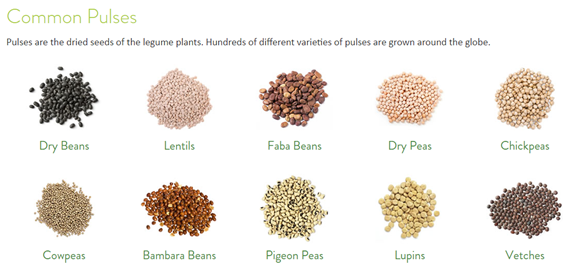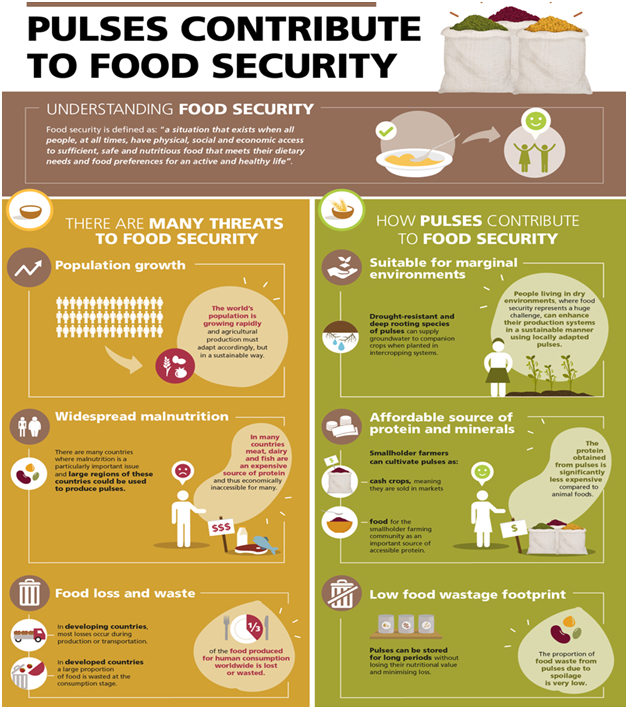

World Pulses Day is observed on February 10 of every year to recognize the importance of pulses as a global food.
Context
|
Sub-topic GS-III: Food Security, Hunger, Malnutrition, Sustainable Development Goals |
World Pulses Day is observed on February 10 of every year to recognize the importance of pulses as a global food.
Background
- The celebration of World Pulses Day’ is an opportunity to heighten public awareness of the nutritional benefits of pulses and their contribution to sustainable food systems and a #ZeroHunger
- Pulses have intrinsic value being packed with nutrients, high protein content, low fat and high fiber, which keeps cholesterol and blood sugar under control.
|
International Year of Pulses (IYP)
|
- Not only do they improve food security and create economic stability, but they also contribute to climate change mitigation by reducing greenhouse gases.
- Pulses play a crucial role in addressing food insecurity and achieving healthy and balanced diets for all, pointing to the need to unlock their full potential to accelerate progress towards the Sustainable Development Goals (SDGs) of the 2030 Agenda.
|
What is International day of Pulses?
|
Analysis
What are Pulses?
- Pulses are the edible seeds of plants in the legume family. Pulses grow in pods and come in a variety of shapes, sizes and colors.
- The United Nations Food and Agriculture Organization (FAO) recognizes 11 types of pulses: dry beans, dry broad beans, dry peas, chickpeas, cow peas, pigeon peas, lentils, Bambara beans, vetches, lupins and pulses nes(not elsewhere specified – minor pulses that don’t fall into one of the other categories).

|
Why ‘hunger’ still continues to grow?
- Despite the global progressthat has been achieved in advancing food security and alleviating poverty, the number of hungry people in the world continues to grow, reductions in child stunting remain insufficient, and obesity is on the rise.
- With more than 840 million people estimated to be undernourished by 2030, the worldis not on track to achieve ‘Zero Hunger’.
- The pandemic has further threatened lives and livelihood by reversing decades of progress on ending hunger and achieving food security.
- A UN World Food Programme (WFP) report indicates a rise in hunger due to the pandemic, with an approximately 270 million people facing food insecurity as opposed to the 149 million during pre-COVID times. This is a matter of grave concern.
|
Global Hunger Index 2020 India ranks 94 out of 107 countries on the Global Hunger Index 2020. It falls under the category of ‘serious’ level of hunger.
|
Correlation between Dietary Diversity and quality of diet
- Researchindicates a direct correlation between dietary diversity—with the quality of diet and household food security—and higher socio-economic status in terms of maternal education and employment.
- According to the NFHS-4 2015-16, only 9.6 percent children (6-23 months) are fed a minimum acceptable diet.
- Going by the latest NFHS-5 for 22 states/UTs, there is a slight improvement in percentage of children receiving an adequate diet, ranging from 5.9 percent in Gujarat to 29.8 percent in Meghalaya.
- In India only 42 percent children (6-23 months) have minimum meal frequency (fed the minimum number of times per day for their age),and a mere 21 percenthave minimum dietary diversity (diet containing four or more food groups—Grains, Pulses and Legumes, Milk and Milk products, Eggs, Fruits and Vegetables, and Fresh Foods).
How Pulses can help India?
Food security exists when all people, at all times, have physical, social and economic access to sufficient, safe and nutritious food which meets their dietary needs and food preferences for an active and healthy life.
Food insecurity is a major issue for many people and households in poor and developing countries—it is estimated that 795 million people are undernourished. Pulses can help contribute to food security in a number of ways.
Health
- According to theEat-Lancet Commission on Food, Planet, Health, India needs to enhance dietary diversity and behaviour change as it is crucial to achieving nutrition security.
- Pulses are inexpensive, easy to store, highly-nutritious.
- FAO suggests ‘Overcoming hunger and malnutrition in the 21st century means increasing food quantity and quality, while making sure we produce food sustainably, efficiently and safely’.
- Pulses contribute 10 percent of dietary protein, with a modest increase in monthly per capita consumption. Supplementingcereal-based diets with pulses can potentially bring down malnutrition.
- Pulses are nutritional powerhouses among all the protein sources as they have zero cholesterol, high content of iron, gluten-free, rich in minerals and vitamins, low-fat content, and an important source of dietary fibre.
- Moreover, pulses are a rich source of fermentable fibre, which is beneficial to maintain the intestine health.
- They feed intestinal bacteria and promote the assimilation of nutrients, thus facilitating proper immune system functioning.
- Pulses can contribute to the overarching issue of food security in a number of ways, as elicited in figure.

Environment
- Lower carbon footprint:Pulse crops have a lower carbon footprint than most foods because they require a small amount of fertilizer to grow.
- Low water footprint:They also have a low water footprint as they are adapted to semi-arid conditions and can tolerate drought stress.
- Enhance soil microbiome: They have the ability to enhance the soil microbiome has been key in improving farming techniques in low-income rural areas.
How Government is ensuring pulses into diet?
- Pulses are an indispensable source of protein in Indian diets. The Government of India’s food security programs provide for 50 percent of the recommended dietary allowance of protein to children, adolescent girls, and pregnant and lactating women.
- The government announced a relief package during the pandemic, providing for an additional supply of 5 kg rice/wheat and 1 kg of preferred pulses per month.
- Some statesnamely Andhra Pradesh, Telangana, Haryana, and Himachal Pradesh have succeeded in providing pulses through the Public Distribution System (PDS).
|
Progress of National Food Security Act
|
Way forward
As a policy, the PDS should provide pulses at subsidised rates to make them more affordable and available. This will provide the much needed nutritional security, especially to the vulnerable section of our population. There is an urgent need to create awareness on the consumption of macronutrient rich pulses for the dual benefit of nutrition and sustainability. For a healthier future generation, act now!


